engine PORSCHE CAYMAN S 2010 1.G Information Manual
[x] Cancel search | Manufacturer: PORSCHE, Model Year: 2010, Model line: CAYMAN S, Model: PORSCHE CAYMAN S 2010 1.GPages: 66, PDF Size: 4.89 MB
Page 19 of 66
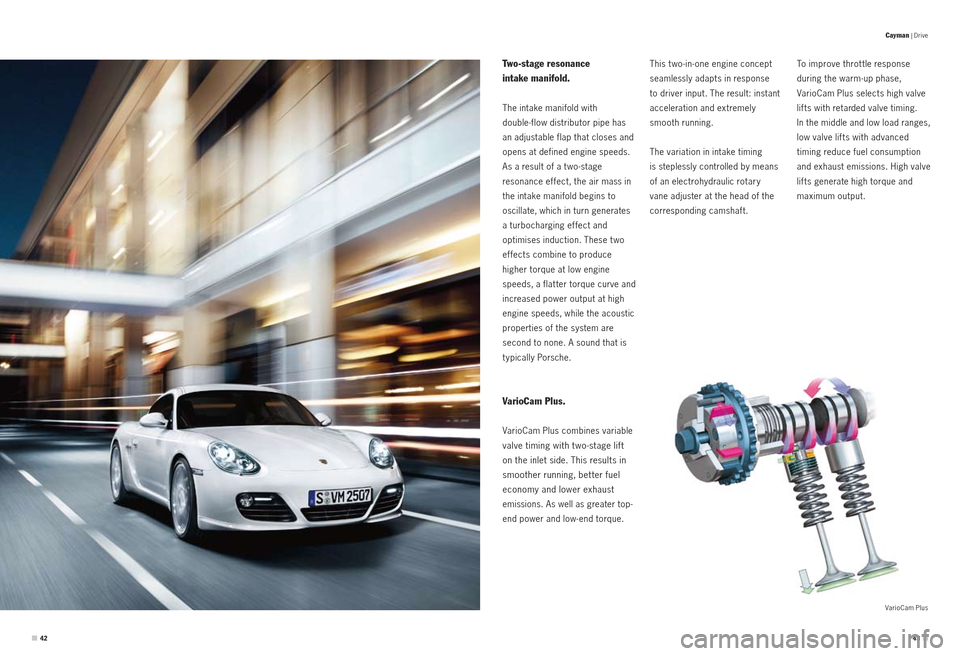
Cayman | Drive
VarioCam Plus
To improve throt tle response
during the warm -up phase,
VarioCam Plus selects high valve
lif ts with retarded valve timing.
In the middle and low load ranges,
low valve lif ts with advanced
timing reduce fuel consumption
and exhaust emissions. High valve
lif ts generate high torque and
maximum output.Two-stage resonance
intake manifold.
The intake manifold with
double-flow distributor pipe has
an adjustable flap that closes and
opens at defined engine speeds.
As a result of a t wo -stage
resonance ef fect, the air mass in
the intake manifold begins to
oscillate, which in turn generates
a turbocharging ef fect and
optimises induction. These t wo
ef fects combine to produce
higher torque at low engine
speeds, a flat ter torque curve and
increased power output at high
engine speeds, while the acoustic
properties of the system are
second to none. A sound that is
typically Porsche.
VarioCam Plus.
VarioCam Plus combines variable
valve timing with t wo -stage lift
on the inlet side. This results in
smoother running, bet ter fuel
economy and lower exhaust
emissions. As well as greater top-
end power and low- end torque. This two-in-one engine concept
seamlessly adapts in response
to driver input. The result: instant
acceleration and extremely
smooth running.
The variation in intake timing
is steplessly controlled by means
of an electrohydraulic rotary
vane adjuster at the head of the
corresponding camshaf t.
4243
Page 20 of 66
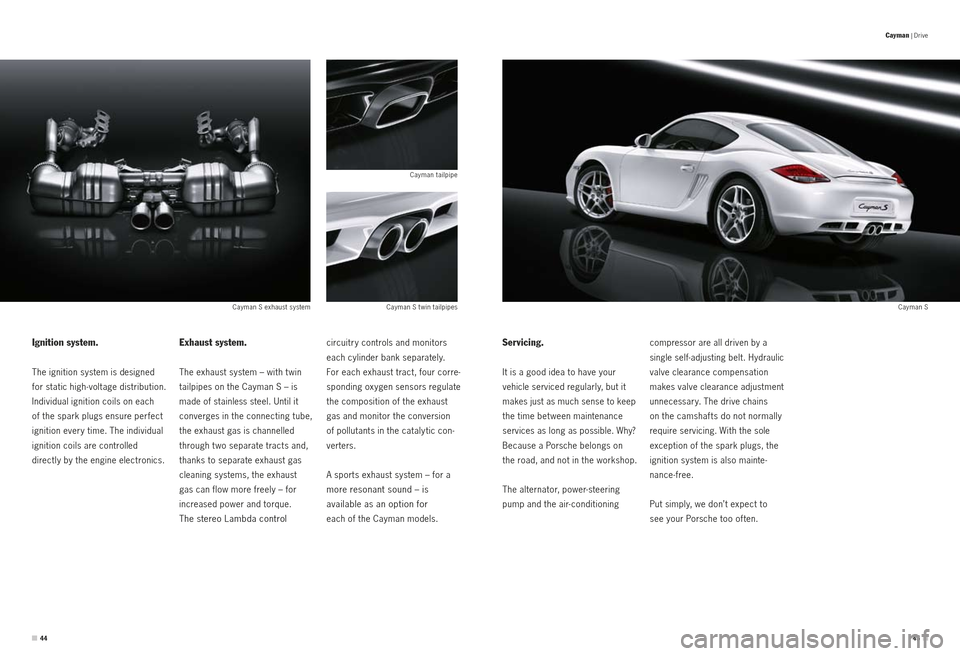
Cayman S exhaust systemCayman S t win tailpipes Cayman S
Cayman tailpipe
circuitry controls and monitors
each cylinder bank separately.
For each exhaust tract, four corre -
sponding oxygen sensors regulate
the composition of the exhaust
gas and monitor the conversion
of pollutants in the cataly tic con -
verters.
A sports exhaust system – for a
more resonant sound – is
available as an option for
each of the Cayman models.
Ignition system.
The ignition system is designed
for static high -voltage distribution.
Individual ignition coils on each
of the spark plugs ensure perfect
ignition every time. The individual
ignition coils are controlled
directly by the engine electronics.
Servicing.
It is a good idea to have your
vehicle serviced regularly, but it
makes just as much sense to keep
the time bet ween maintenance
services as long as possible. Why?
Because a Porsche belongs on
the road, and not in the workshop.
The alternator, power-steering
pump and the air- conditioning
Exhaust system.
The exhaust system – with t win
tailpipes on the Cayman S – is
made of stainless steel. Until it
converges in the connecting tube,
the exhaust gas is channelled
through t wo separate tracts and,
thanks to separate exhaust gas
cleaning systems, the exhaust
gas can flow more freely – for
increased power and torque.
The stereo Lambda control
compressor are all driven by a
single self-adjusting belt. Hydraulic
valve clearance compensation
makes valve clearance adjustment
unnecessary. The drive chains
on the camshaf ts do not normally
require servicing. With the sole
exception of the spark plugs, the
ignition system is also mainte -
nance -free.
Put simply, we don’t expect to
see your Porsche too often.
Cayman | Drive
4445
Page 22 of 66
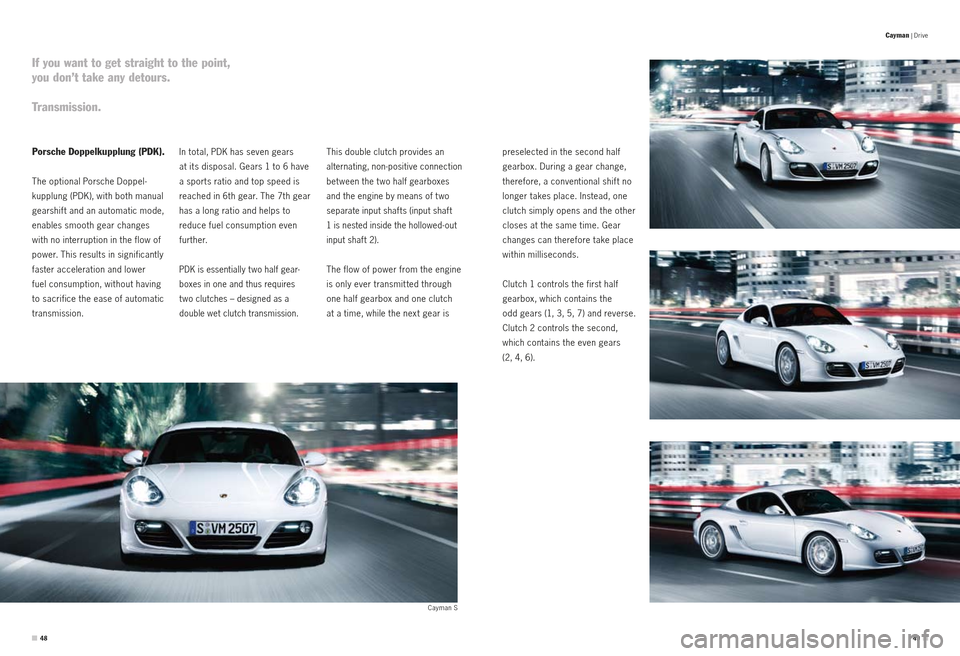
If you want to get straight to the point,
you don’t take any detours.
Transmission.
Cayman S
This double clutch provides an
alternating, non-positive connection
bet ween the t wo half gearboxes
and the engine by means of t wo
separate input shafts (input shaft
1 is nested inside the hollowed-out
input shaft 2).
The flow of power from the engine
is only ever transmit ted through
one half gearbox and one clutch
at a time, while the next gear is preselected in the second half
gearbox. During a gear change,
therefore, a conventional shif t no
longer takes place. Instead, one
clutch simply opens and the other
closes at the same time. Gear
changes can therefore take place
within milliseconds.
Clutch 1 controls the first half
gearbox, which contains the
odd gears (1, 3, 5, 7) and reverse.
Clutch 2 controls the second,
which contains the even gears
(2, 4, 6).
Porsche Doppelkupplung (PDK).
The optional Porsche Doppel -
kupplung (PDK), with both manual
gearshif t and an automatic mode,
enables smooth gear changes
with no interruption in the flow of
power. This results in significantly
faster acceleration and lower
fuel consumption, without having
to sacrifice the ease of automatic
transmission. In total, PDK has seven gears
at its disposal. Gears 1 to 6 have
a sports ratio and top speed is
reached in 6th gear. The 7th gear
has a long ratio and helps to
reduce fuel consumption even
f u rt h e r.
PDK is essentially t wo half gear -
boxes in one and thus requires
t wo clutches – designed as a
double wet clutch transmission.
Cayman | Drive
4849
Page 23 of 66
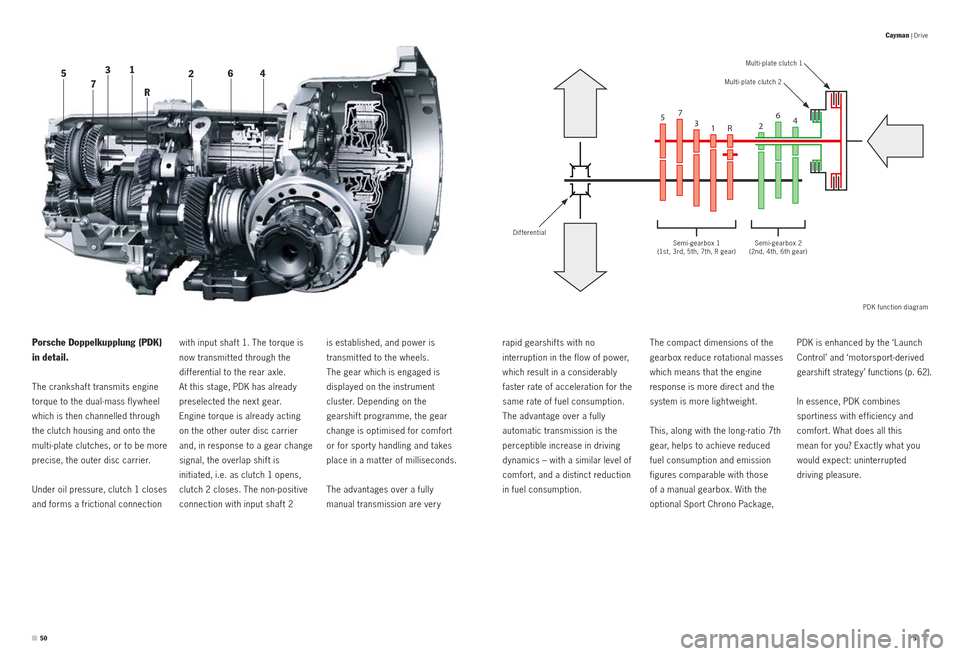
Multi - plate clutch 1
Multi - plate clutch 2
Semi -gearbox 2
(2nd, 4th, 6th gear)
Semi -gearbox 1
(1st, 3rd, 5th, 7th, R gear)
Differential
P DK function diagram
is established, and power is
transmit ted to the wheels.
The gear which is engaged is
displayed on the instrument
cluster. Depending on the
gearshif t programme, the gear
change is optimised for comfort
or for sport y handling and takes
place in a mat ter of milliseconds.
The advantages over a fully
manual transmission are very PDK is enhanced by the ‘Launch
Control’ and ‘motorsport- derived
gearshift strategy’ functions (p. 62).
In essence, PDK combines
sportiness with ef ficiency and
comfort. What does all this
mean for you? Exactly what you
would expect: uninterrupted
driving pleasure.
Porsche Doppelkupplung (PDK)
in detail.
The crankshaf t transmits engine
torque to the dual-mass fly wheel
which is then channelled through
the clutch housing and onto the
multi-plate clutches, or to be more
precise, the outer disc carrier.
Under oil pressure, clutch 1 closes
and forms a frictional connection rapid gearshif ts with no
interruption in the flow of power,
which result in a considerably
faster rate of acceleration for the
same rate of fuel consumption.
The advantage over a fully
automatic transmission is the
perceptible increase in driving
dynamics – with a similar level of
comfort, and a distinct reduction
in fuel consumption.
with input shaft 1. The torque is
now transmit ted through the
dif ferential to the rear axle.
At this stage, PDK has already
preselected the next gear.
Engine torque is already acting
on the other outer disc carrier
and, in response to a gear change
signal, the overlap shift is
initiated, i.e. as clutch 1 opens,
clutch 2 closes. The non-positive
connection with input shaf t 2 The compact dimensions of the
gearbox reduce rotational masses
which means that the engine
response is more direct and the
system is more light weight.
This, along with the long-ratio 7th
gear, helps to achieve reduced
fuel consumption and emission
figures comparable with those
of a manual gearbox. With the
optional Sport Chrono Package,
Cayman | Drive
50
46
2
1
R
7 3
5
51
4
6
2
R1
3
7
5
Page 24 of 66
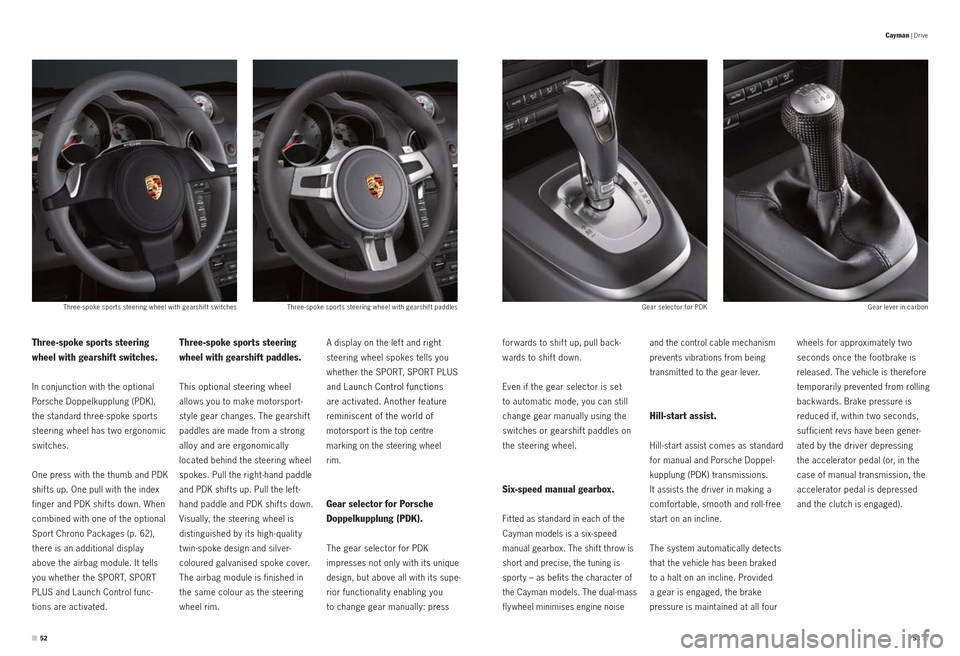
Three -spoke sports steering wheel with gearshif t paddles
Three -spoke sports steering wheel with gearshif t switches Gear selector for PDKGear lever in carbon
A display on the left and right
steering wheel spokes tells you
whether the SPORT, SPORT PLUS
and Launch Control functions
are activated. Another feature
reminiscent of the world of
motorsport is the top centre
marking on the steering wheel
rim.
Gear selector for Porsche
Doppelkupplung (PDK).
The gear selector for PDK
impresses not only with its unique
design, but above all with its supe -
rior functionalit y enabling you
to change gear manually: press wheels for approximately t wo
seconds once the footbrake is
released. The vehicle is therefore
temporarily prevented from rolling
backwards. Brake pressure is
reduced if, within t wo seconds,
sufficient revs have been gener
-
ated by the driver depressing
the accelerator pedal (or, in the
case of manual transmission, the
accelerator pedal is depressed
and the clutch is engaged).
Three-spoke sports steering
wheel with gearshift switches.
In conjunction with the optional
Porsche Doppelkupplung (PDK),
the standard three-spoke sports
steering wheel has t wo ergonomic
switches.
One press with the thumb and PDK
shif ts up. One pull with the index
finger and PDK shif ts down. When
combined with one of the optional
Sport Chrono Packages (p. 62),
there is an additional display
above the airbag module. It tells
you whether the SPORT, SPORT
PLUS and Launch Control func -
tions are activated. forwards to shift up, pull back
-
wards to shift down.
Even if the gear selector is set
to automatic mode, you can still
change gear manually using the
switches or gearshif t paddles on
the steering wheel.
Six-speed manual gearbox.
Fit ted as standard in each of the
Cayman models is a six-speed
manual gearbox. The shift throw is
short and precise, the tuning is
sport y – as befits the character of
the Cayman models. The dual-mass
fly wheel minimises engine noise
Three-spoke sports steering
wheel with gearshift paddles.
This optional steering wheel
allows you to make motorsport-
st yle gear changes. The gearshift
paddles are made from a strong
alloy and are ergonomically
located behind the steering wheel
spokes. Pull the right-hand paddle
and PDK shifts up. Pull the left-
hand paddle and PDK shifts down.
Visually, the steering wheel is
distinguished by its high-qualit y
t win -spoke design and silver-
coloured galvanised spoke cover.
The airbag module is finished in
the same colour as the steering
wheel rim.
and the control cable mechanism
prevents vibrations from being
transmit ted to the gear lever.
Hill-start assist.
Hill-start assist comes as standard
for manual and Porsche Doppel -
kupplung (PDK) transmissions.
It assists the driver in making a
comfortable, smooth and roll-free
start on an incline.
The system automatically detects
that the vehicle has been braked
to a halt on an incline. Provided
a gear is engaged, the brake
pressure is maintained at all four
Cayman | Drive
5253
Page 26 of 66
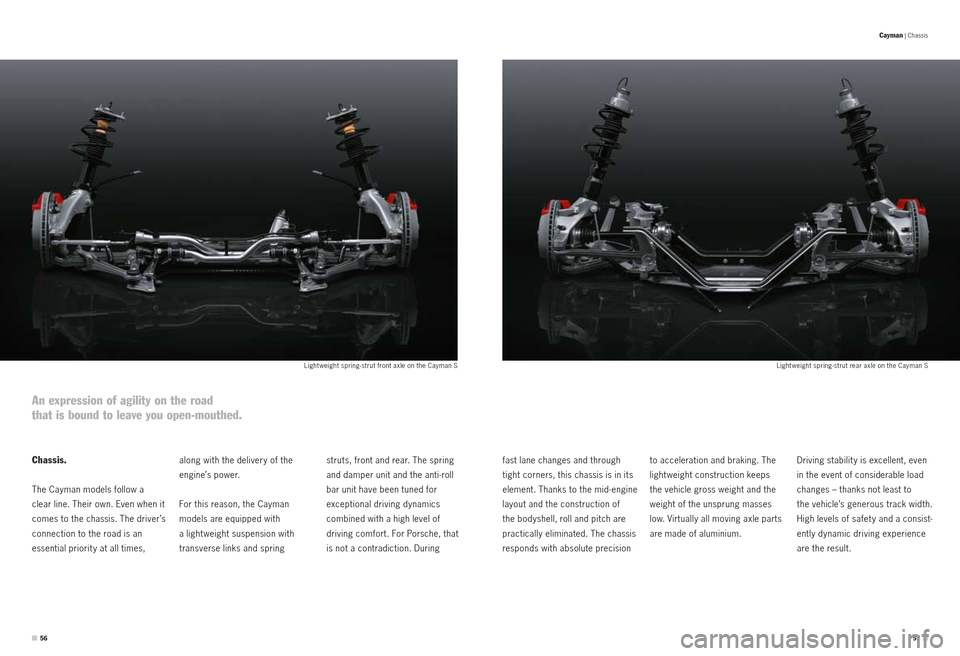
Light weight spring-strut front axle on the Cayman SLight weight spring-strut rear axle on the Cayman S
struts, front and rear. The spring
and damper unit and the anti-roll
bar unit have been tuned for
exceptional driving dynamics
combined with a high level of
driving comfort. For Porsche, that
is not a contradiction. During Driving stabilit y is excellent, even
in the event of considerable load
changes – thanks not least to
the vehicle’s generous track width.
High levels of safet y and a consist -
ently dynamic driving experience
are the result.Chassis.
The Cayman models follow a
clear line. Their own. Even when it
comes to the chassis. The driver’s
connection to the road is an
essential priorit y at all times, fast lane changes and through
tight corners, this chassis is in its
element. Thanks to the mid- engine
layout and the construction of
the bodyshell, roll and pitch are
practically eliminated. The chassis
responds with absolute precision
along with the delivery of the
engine’s power.
For this reason, the Cayman
models are equipped with
a light weight suspension with
transverse links and spring to acceleration and braking. The
light weight construction keeps
the vehicle gross weight and the
weight of the unsprung masses
low. Virtually all moving axle parts
are made of aluminium.
An expression of agility on the road
that is bound to leave you open-mouthed.
Cayman | Chassis
5657
Page 27 of 66
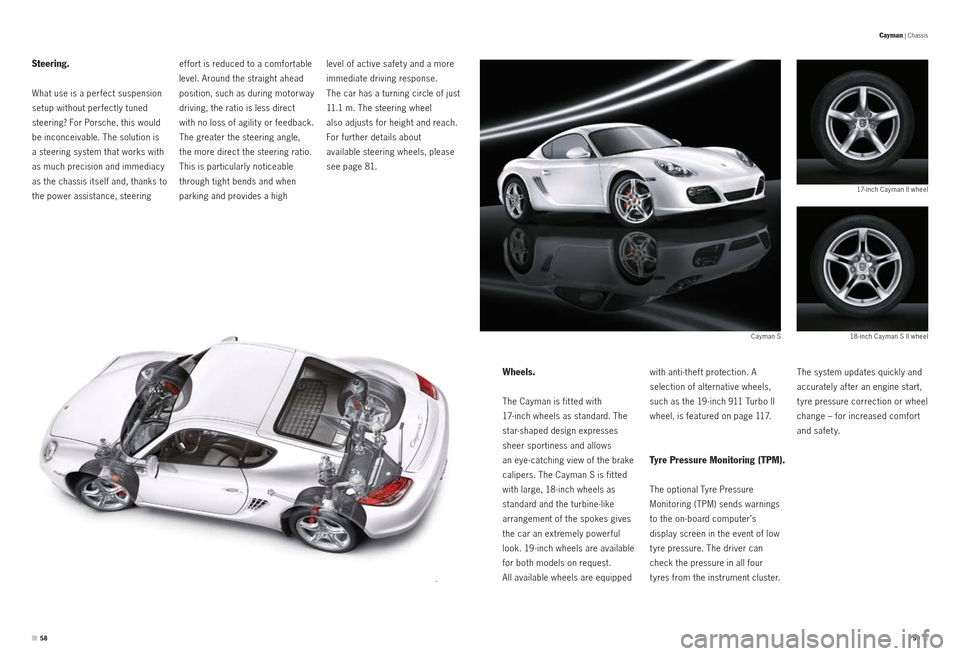
y C ayman S
17- inch Cayman II wheel
18 - inch Cayman S II wheel
level of active safet y and a more
immediate driving response.
The car has a turning circle of just
11.1 m. The steering wheel
also adjusts for height and reach.
For further details about
available steering wheels, please
see page 81.
The system updates quickly and
accurately after an engine start,
t yre pressure correction or wheel
change – for increased comfort
and safet y.Steering.
What use is a perfect suspension
setup without perfectly tuned
steering? For Porsche, this would
be inconceivable. The solution is
a steering system that works with
as much precision and immediacy
as the chassis itself and, thanks to
the power assistance, steering
Wheels.
The Cayman is fit ted with
17-inch wheels as standard. The
star-shaped design expresses
sheer sportiness and allows
an eye- catching view of the brake
calipers. The Cayman S is fit ted
with large, 18-inch wheels as
standard and the turbine-like
arrangement of the spokes gives
the car an extremely powerful
look. 19 -inch wheels are available
for both models on request.
All available wheels are equipped
ef fort is reduced to a comfortable
level. Around the straight ahead
position, such as during motorway
driving, the ratio is less direct
with no loss of agilit y or feedback.
The greater the steering angle,
the more direct the steering ratio.
This is particularly noticeable
through tight bends and when
parking and provides a high
with anti-thef t protection. A
selection of alternative wheels,
such as the 19 -inch 911 Turbo II
wheel, is featured on page 117.
Tyre Pressure Monitoring (TPM).
The optional Tyre Pressure
Monitoring (TPM) sends warnings
to the on -board computer’s
display screen in the event of low
t yre pressure. The driver can
check the pressure in all four
t yres from the instrument cluster.
Cayman | Chassis
5859
Page 29 of 66
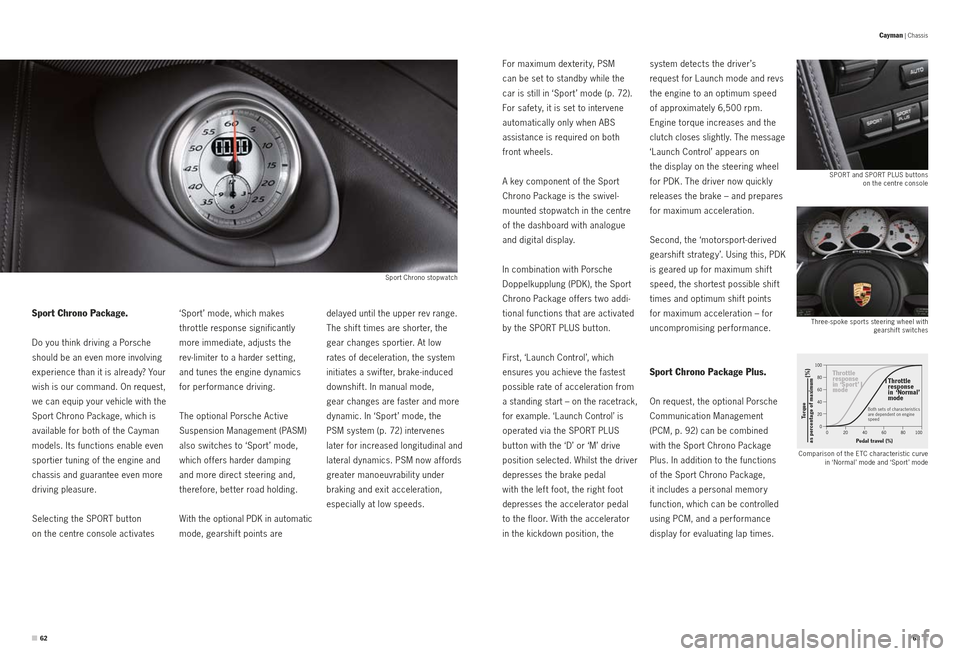
Sport Chrono stopwatchSPORT and SPORT PLUS but tons
on the centre console
Three -spoke sports steering wheel with gearshif t switches
For maximum dexterit y, PSM
can be set to standby while the
car is still in ‘Sport ’ mode (p. 72).
For safet y, it is set to intervene
automatically only when ABS
assistance is required on both
front wheels.
A key component of the Sport
Chrono Package is the swivel-
mounted stopwatch in the centre
of the dashboard with analogue
and digital display.
In combination with Porsche
Doppelkupplung (PDK), the Sport
Chrono Package offers t wo addi -
tional functions that are activated
by the SPORT PLUS but ton.
First, ‘Launch Control’, which
ensures you achieve the fastest
possible rate of acceleration from
a standing start – on the racetrack,
for example. ‘Launch Control’ is
operated via the SPORT PLUS
but ton with the ‘D’ or ‘M’ drive
position selected. Whilst the driver
depresses the brake pedal
with the lef t foot, the right foot
depresses the accelerator pedal
to the floor. With the accelerator
in the kickdown position, the
delayed until the upper rev range.
The shif t times are shorter, the
gear changes sportier. At low
rates of deceleration, the system
initiates a swif ter, brake-induced
downshift. In manual mode,
gear changes are faster and more
dynamic. In ‘Sport ’ mode, the
PSM system (p. 72) intervenes
later for increased longitudinal and
lateral dynamics. PSM now af fords
greater manoeuvrabilit y under
braking and exit acceleration,
especially at low speeds.
Sport Chrono Package.
Do you think driving a Porsche
should be an even more involving
experience than it is already? Your
wish is our command. On request,
we can equip your vehicle with the
Sport Chrono Package, which is
available for both of the Cayman
models. Its functions enable even
sportier tuning of the engine and
chassis and guarantee even more
driving pleasure.
Selecting the SPORT but ton
on the centre console activates ‘Sport ’ mode, which makes
throt tle response significantly
more immediate, adjusts the
rev-limiter to a harder set ting,
and tunes the engine dynamics
for performance driving.
The optional Porsche Active
Suspension Management (PASM)
also switches to ‘Sport ’ mode,
which of fers harder damping
and more direct steering and,
therefore, bet ter road holding.
With the optional PDK in automatic
mode, gearshif t points are system detects the driver’s
request for Launch mode and revs
the engine to an optimum speed
of approximately 6,500 rpm.
Engine torque increases and the
clutch closes slightly. The message
‘Launch Control’ appears on
the display on the steering wheel
for PDK. The driver now quickly
releases the brake – and prepares
for maximum acceleration.
Second, the ‘motorsport- derived
gearshif t strategy’. Using this, PDK
is geared up for maximum shif t
speed, the shortest possible shif t
times and optimum shif t points
for maximum acceleration – for
uncompromising performance.
Sport Chrono Package Plus.
On request, the optional Porsche
Communication Management
(PCM, p. 92) can be combined
with the Sport Chrono Package
Plus. In addition to the functions
of the Sport Chrono Package,
it includes a personal memory
function, which can be controlled
using PCM, and a performance
display for evaluating lap times.
Throttle
response
in ‘Sport’
mode Throttle
response
in ‘Normal’
mode
Both sets of characteristics
are dependent on engine
speed
Pedal travel (%)
(%)
Torque
as percentage of maximum
Comparison of the ETC characteristic curve in ‘Normal’ mode and ‘Sport ’ mode
Cayman | Chassis
6263
Page 32 of 66

Porsche Ceramic Composite Brake (PCCB)Standard brake unit (Cayman S)
Standard brake unit (Cayman)
Braking system.
The acceleration of the Cayman
models is impressive. Even
more impressive, perhaps, is the
vehicle’s maximum braking power,
which comfortably tames the
power of the engine.
Four-piston aluminium monobloc
brake calipers are fit ted front and
rear. Offering excellent rigidit y,
they are compact and save on
weight. Their superior responsive -
ness, for fast and sensitive
braking, sets them apart. A brake
booster provides assistance,
reducing pedal effort whilst main -
taining a powerful braking effect.
A special ventilation system,
whereby the entire wheel brake
is supplied with cooling air
by openings in the front end and
special channelling systems,
increases the stabilit y of
the brakes during heav y use. The front axle of the Cayman
and Cayman S features internally
vented brake discs with a diameter
of 318 mm. 299 mm brake
discs are fit ted to the rear axle.
The result is outstanding braking
performance. The rear brake discs
of the Cayman S are 4 mm thicker
than those of the Cayman, which
increases stabilit y under load
even further. To distinguish them
visually, the brake calipers on the
Cayman have a black anodised
finish while those on the Cayman S
are painted red.
For reduced weight, optimum
braking in the wet and improved
cooling, the brake discs on
both models are cross- drilled.
For the Cayman S, the Porsche
Ceramic Composite Brake (PCCB)
is available as an option.
Cayman | Safet y
6869
Page 34 of 66
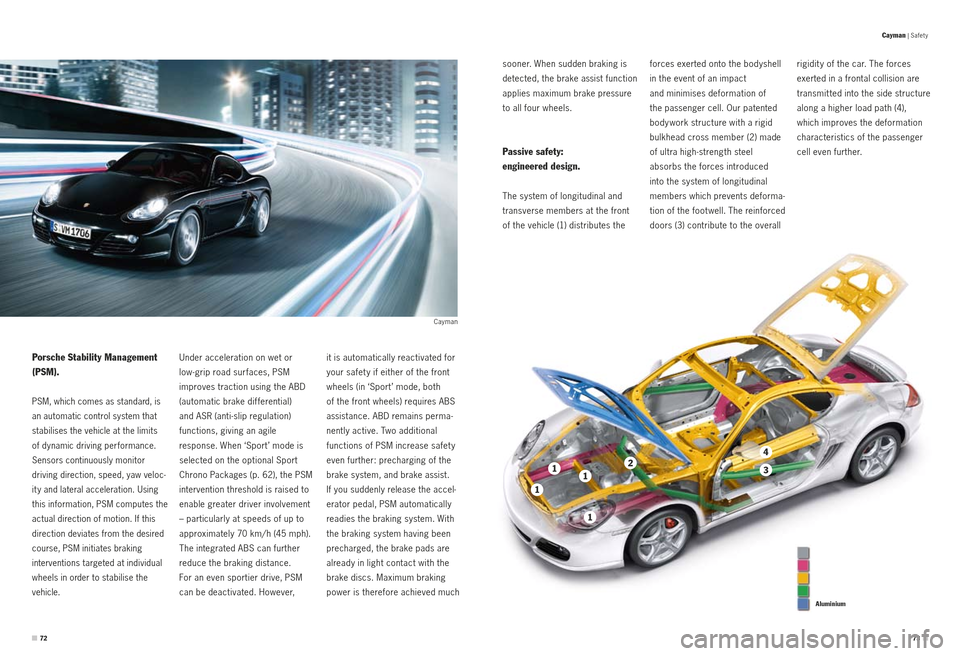
Aluminium
it is automatically reactivated for
your safet y if either of the front
wheels (in ‘Sport ’ mode, both
of the front wheels) requires ABS
assistance. ABD remains perma -
nently active. Two additional
functions of PSM increase safet y
even further: precharging of the
brake system, and brake assist.
If you suddenly release the accel -
erator pedal, PSM automatically
readies the braking system. With
the braking system having been
precharged, the brake pads are
already in light contact with the
brake discs. Maximum braking
power is therefore achieved much rigidit y of the car. The forces
exerted in a frontal collision are
transmit ted into the side structure
along a higher load path (4),
which improves the deformation
characteristics of the passenger
cell even further.Porsche Stability Management
(PSM).
PSM, which comes as standard, is
an automatic control system that
stabilises the vehicle at the limits
of dynamic driving performance.
Sensors continuously monitor
driving direction, speed, yaw veloc-
it y and lateral acceleration. Using
this information, PSM computes the
actual direction of motion. If this
direction deviates from the desired
course, PSM initiates braking
interventions targeted at individual
wheels in order to stabilise the
vehicle.
sooner. When sudden braking is
detected, the brake assist function
applies maximum brake pressure
to all four wheels.
Passive safety:
engineered design.
The system of longitudinal and
transverse members at the front
of the vehicle (1) distributes the
Under acceleration on wet or
low-grip road surfaces, PSM
improves traction using the ABD
(automatic brake differential)
and ASR (anti-slip regulation)
functions, giving an agile
response. When ‘Sport ’ mode is
selected on the optional Sport
Chrono Packages (p. 62), the PSM
intervention threshold is raised to
enable greater driver involvement
– particularly at speeds of up to
approximately 70 km/ h (45 mph).
The integrated ABS can further
reduce the braking distance.
For an even sportier drive, PSM
can be deactivated. However, forces exerted onto the bodyshell
in the event of an impact
and minimises deformation of
the passenger cell. Our patented
body work structure with a rigid
bulkhead cross member (2) made
of ultra high -strength steel
absorbs the forces introduced
into the system of longitudinal
members which prevents deforma -
tion of the foot well. The reinforced
doors (3) contribute to the overall
Cayman
Cayman | Safet y
7273
1
1
1
23
4
1